warning light SKODA SUPERB 2009 2.G / (B6/3T) Owner's Manual
[x] Cancel search | Manufacturer: SKODA, Model Year: 2009, Model line: SUPERB, Model: SKODA SUPERB 2009 2.G / (B6/3T)Pages: 294, PDF Size: 21.33 MB
Page 226 of 294

Inspecting and replenishing
225
Using the system
Safety
Driving Tips
General Maintenance
Breakdown assistance
Technical Data
– Wait a few minutes and pull out the oil dipstick. – Wipe off the dipstick with a clea
n cloth and insert it again fully.
– Then withdraw the dipstick ag
ain and read off the oil level.
Oil level within range – You must
not
top up the oil.
Oil level within range – You
may
top up the oil. It is possible that the oil level may then be
within range after doing this.
Oil level within range – You
must
top up the oil
⇒
page 225. It is sufficient, once this is done,
to keep the oil level within range .
It is normal for the engine to consume oi
l. The oil consumption may be as much as
0.5 l/1 000 km depending on your style of
driving and the conditions under which
you operate your vehicle. Th
e oil consumption may be sl
ightly higher than this
during the first 5 000 kilometres. One should therefore check the oil level at regular intervals, preferably every time after the fuel tank is filled or after driving for long stretches. We recommend maintaining the oil level within the range -
but not above this
,
if the engine has been operating at high loads, for example during a lengthy motorway trip during the
summer months, towing a trai
ler or negotiating a high
mountain pass. The warning light in the instrument cluster* will indicate
⇒page 42, “Engine oil
level
” whether the oil level is too low. In this case, check the oil level as soon as
possible. Top up with an appropriate quantity of oil.
Caution
•
The oil level must on no account ex
tend beyond the ra
nge . Danger of
damaging the catalytic converter.
•
Do not continue your journey
if for some reason it is not possible under the
conditions prev
ailing to top up with oil.
Switch of the engine and contact
and
obtain professional assistance from a specialist garage.
Note
Engine oil specifications
⇒page 270.
Replenishing engine oil– Inspecting the engine oil level
⇒
page 224.
– Unscrew the cap of the engine oil filler opening.– Pour in a suitable grade of oil in portions of 0.5 litres
⇒
page 270.
– Inspect the oil level
⇒
page 224, “Check engine oil level”.
– Carefully screw on the cap of the filler opening and push the dipstick
in fully.
WARNING
•
Avoid dripping oil onto hot parts of the engine when topping up will oil -
a risk of fire!•
Read and observe the warning notes
⇒page 223, “Working in the engine
compartment” before working in the engine compartment.
For the sake of the environment
The oil level must on no account be above the range
⇒page 224. Oil will other-
wise be drawn in through the crankcas
e ventilation and may pass through the
exhaust system to atmosphere. The oil ma
y combust in the catalytic converter and
damage it.
AAAB
AA
AC
AB
AA
AA
Aa
s2dk.1.book Page 225 Wednesday, April 8, 2009 12:23 PM
Page 228 of 294
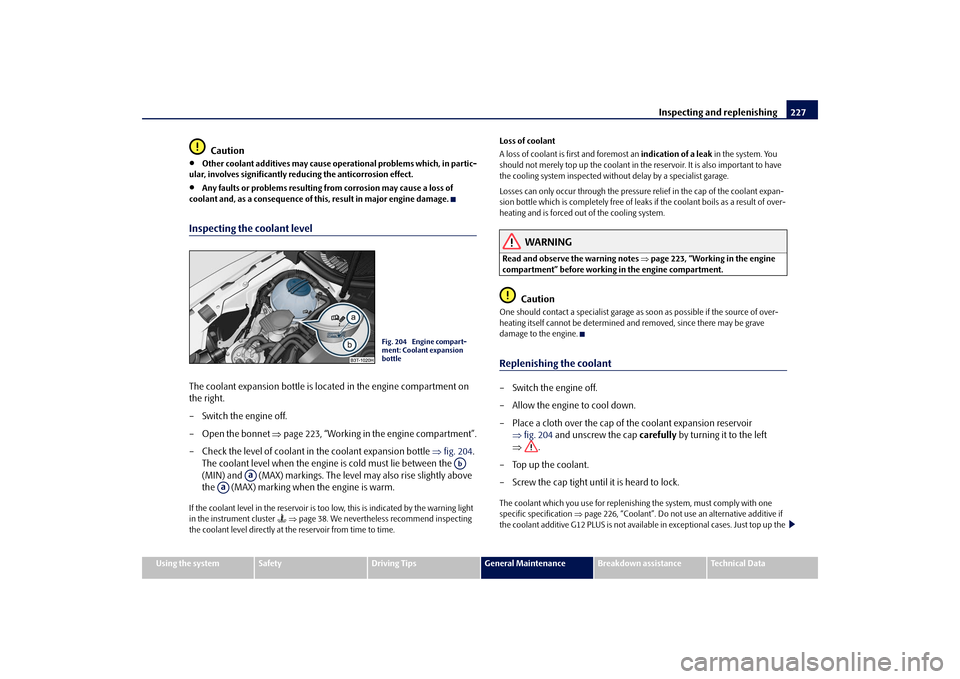
Inspecting and replenishing
227
Using the system
Safety
Driving Tips
General Maintenance
Breakdown assistance
Technical Data
Caution
•
Other coolant additives may cause operational problems which, in partic-
ular, involves significantly redu
cing the anticorrosion effect.
•
Any faults or problems resulting from corrosion may cause a loss of
coolant and, as a consequence of th
is, result in major engine damage.
Inspecting the coolant levelThe coolant expansion bott
le is located in the engine compartment on
the right. – Switch the engine off. – Open the bonnet
⇒
page 223, “Working in the engine compartment”.
– Check the level of coolant in
the coolant expansion bottle
⇒
fig. 204
.
The coolant level when the engine is cold must lie between the (MIN) and (MAX) markings. The level may also rise slightly above the (MAX) marking when the engine is warm.
If the coolant level in the reservoir is too low, this is indicated by the warning light in the instrument cluster
⇒page 38. We nevertheless recommend inspecting
the coolant level directly at the reservoir from time to time.
Loss of coolant A loss of coolant is first and foremost an
indication of a leak
in the system. You
should not merely top up the coolant in the
reservoir. It is also important to have
the cooling system inspected without delay by a specialist garage. Losses can only occur through the pressure relief in the cap of the coolant expan- sion bottle which is completely free of leak
s if the coolant boils as a result of over-
heating and is forced out of the cooling system.
WARNING
Read and observe the warning notes
⇒page 223, “Working in the engine
compartment” before working in the engine compartment.
Caution
One should contact a specialist garage as
soon as possible if the source of over-
heating itself cannot be determined
and removed, since there may be grave
damage to the engine.Replenishing the coolant– Switch the engine off. – Allow the engine to cool down.– Place a cloth over the cap of the coolant expansion reservoir
⇒
fig. 204
and unscrew the cap
carefully
by turning it to the left
⇒
.
– Top up the coolant. – Screw the cap tight until it is heard to lock.The coolant which you use for replenishi
ng the system, must comply with one
specific specification
⇒page 226, “Coolant”. Do not use an alternative additive if
the coolant additive G12 PLUS is not available in exceptional cases. Just top up the
Fig. 204 Engine compart- ment: Coolant expansion bottle
Ab
Aa
Aa
s2dk.1.book Page 227 Wednesday, April 8, 2009 12:23 PM
Page 229 of 294
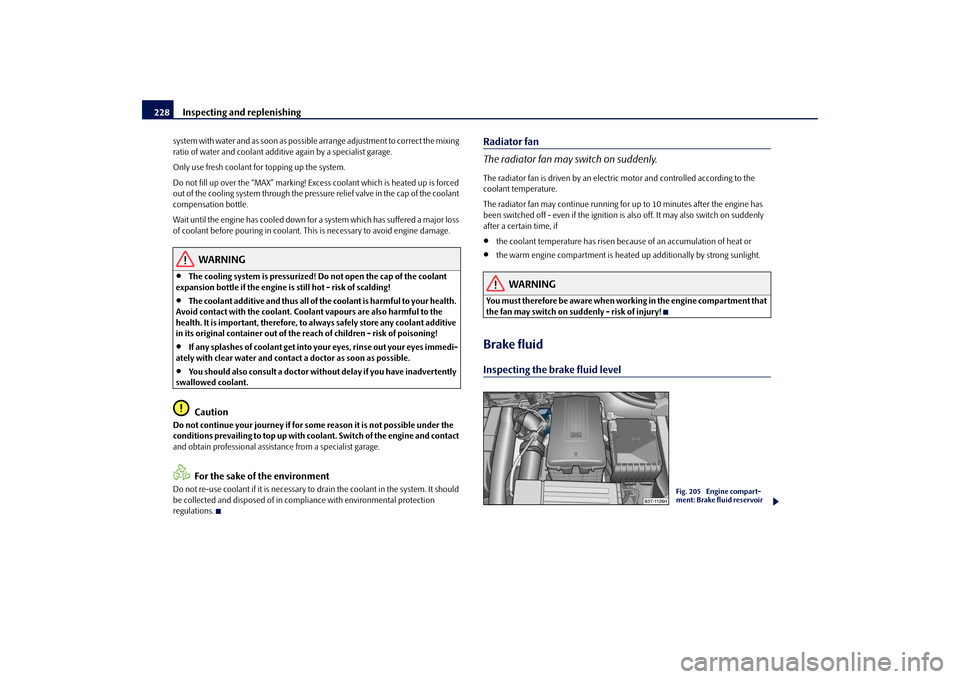
Inspecting and replenishing
228
system with water and as soon as possible
arrange adjustment to correct the mixing
ratio of water and coolant additive again by a specialist garage. Only use fresh coolant for topping up the system.Do not fill up over the “MAX” marking! Exce
ss coolant which is heated up is forced
out of the cooling system through the pressure relief valve in the cap of the coolant compensation bottle. Wait until the engine has cooled down for a system which has suffered a major loss of coolant before pouring in coolant. Th
is is necessary to
avoid engine damage.
WARNING
•
The cooling system is pressurized! Do not open the cap of the coolant
expansion bottle if the engine is still hot - risk of scalding!•
The coolant additive and thus all of the coolant is harmful to your health.
Avoid contact with the coolant. Coolant vapours are also harmful to the health. It is important, therefore, to always safely store any coolant additive in its original container out of the reach of children - risk of poisoning!•
If any splashes of coolant get into yo
ur eyes, rinse out your eyes immedi-
ately with clear water and contact
a doctor as soon as possible.
•
You should also consult a doctor without delay if you have inadvertently
swallowed coolant.
Caution
Do not continue your journey if for some reason it is not possible under the conditions prevailing to top up with coolant. Switch of the engine and contact
and obtain professional assistan
ce from a specialist garage.
For the sake of the environment
Do not re-use coolant if it is necessary to
drain the coolant in the system. It should
be collected and disposed of in comp
liance with environmental protection
regulations.
Radiator fan The radiator fan may switch on suddenly.The radiator fan is driven by an electric motor and controlled according to the coolant temperature. The radiator fan may continue running for
up to 10 minutes after the engine has
been switched off - even if the ignition is
also off. It may al
so switch on suddenly
after a certain time, if•
the coolant temperature has risen because of an accumulation of heat or
•
the warm engine compartment is heated
up additionally by strong sunlight.
WARNING
You must therefore be aware when work
ing in the engine compartment that
the fan may switch on suddenly - risk of injury!Brake fluidInspecting the brake fluid level
Fig. 205 Engine compart- ment: Brake fluid reservoir
s2dk.1.book Page 228 Wednesday, April 8, 2009 12:23 PM
Page 230 of 294
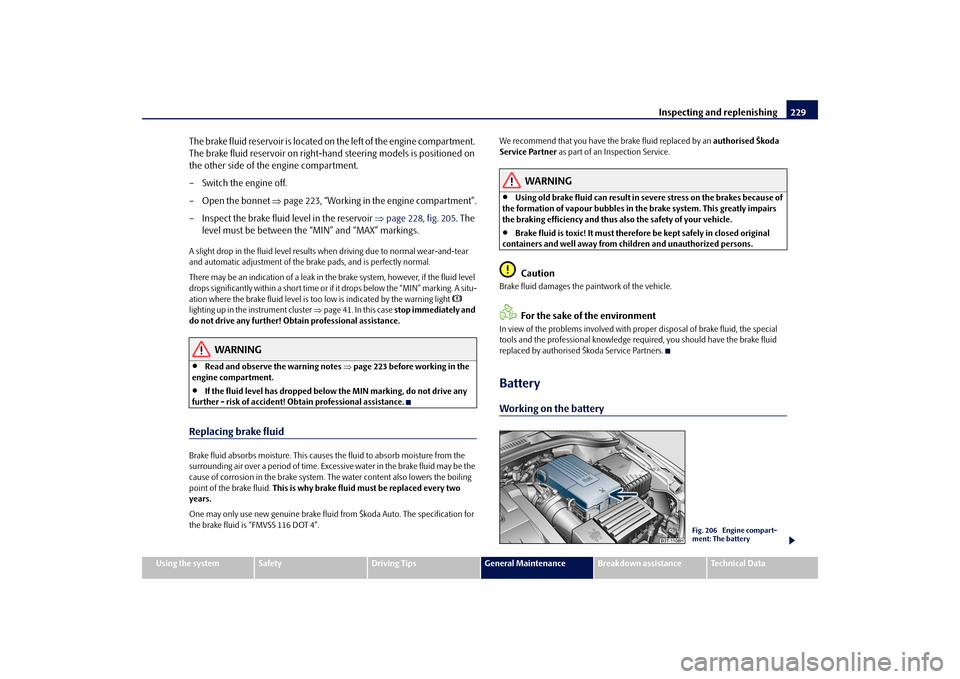
Inspecting and replenishing
229
Using the system
Safety
Driving Tips
General Maintenance
Breakdown assistance
Technical Data
The brake fluid reservoir is located on
the left of the engine compartment.
The brake fluid reservoir on right-hand
steering models is positioned on
the other side of the engine compartment. – Switch the engine off. – Open the bonnet
⇒
page 223, “Working in the engine compartment”.
– Inspect the brake fluid level in the reservoir
⇒
page 228, fig. 205
. The
level must be between the “MIN” and “MAX” markings.
A slight drop in the fluid level results when driving due to normal wear-and-tear and automatic adjustment of the br
ake pads, and is perfectly normal.
There may be an indication of a leak in the brake system, however, if the fluid level drops significantly within a short time or if it drops below the “MIN” marking. A situ- ation where the brake fluid level is too low is indicated by the warning light
lighting up in the instrument cluster
⇒page 41. In this case
stop immediately and
do not drive any further! Obtain professional assistance.
WARNING
•
Read and observe the warning notes
⇒page 223 before working in the
engine compartment.•
If the fluid level has dropped below the MIN marking, do not drive any
further - risk of accident! Obtain professional assistance.Replacing brake fluidBrake fluid absorbs moisture. This causes the fluid to absorb moisture from the surrounding air over a period of time. Excessive water in the brake fluid may be the cause of corrosion in the brake system. Th
e water content also lowers the boiling
point of the brake fluid.
This is why brake fluid mu
st be replaced every two
years. One may only use new genuine brake fluid
from Škoda Auto. The specification for
the brake fluid is “FMVSS 116 DOT 4”.
We recommend that you have th
e brake fluid replaced by an
authorised Škoda
Service Partner
as part of an Inspection Service.
WARNING
•
Using old brake fluid can result in seve
re stress on the brakes because of
the formation of vapour bubbles in th
e brake system. This greatly impairs
the braking efficiency and thus al
so the safety of your vehicle.
•
Brake fluid is toxic! It must therefor
e be kept safely in closed original
containers and well away from children and unauthorized persons.
Caution
Brake fluid damages the paintwork of the vehicle.
For the sake of the environment
In view of the problems involved with prop
er disposal of brak
e fluid, the special
tools and the professional knowledge required, you should have the brake fluid replaced by authorised Škoda Service Partners.BatteryWorking on the battery
Fig. 206 Engine compart- ment: The battery
s2dk.1.book Page 229 Wednesday, April 8, 2009 12:23 PM
Page 231 of 294
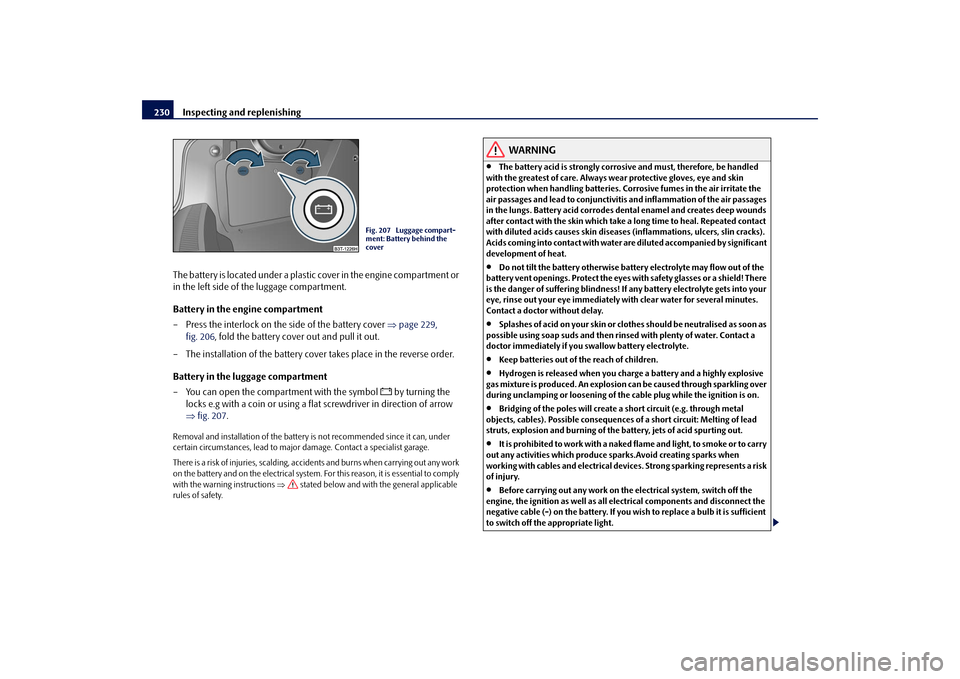
Inspecting and replenishing
230
The battery is located under a plastic cover in the engine compartment or in the left side of the luggage compartment. Battery in the engine compartment – Press the interlock on the side of the battery cover
⇒
page 229,
fig. 206
, fold the battery cover out and pull it out.
– The installation of the battery co
ver takes place in the reverse order.
Battery in the luggage compartment – You can open the compartment with the symbol
by turning the
locks e.g with a coin or using a flat screwdriver in direction of arrow ⇒
fig. 207
.
Removal and installation of the battery
is not recommended since it can, under
certain circumstances, le
ad to major damage. Contact a specialist garage.
There is a risk of injuries, scalding, acci
dents and burns when carrying out any work
on the battery and on the electrical system.
For this reason, it is essential to comply
with the warning instructions
⇒
stated below and with the general applicable
rules of safety.
WARNING
•
The battery acid is strongly corros
ive and must, therefore, be handled
with the greatest of care. Always we
ar protective gloves, eye and skin
protection when handling batteries. Corrosive fumes in the air irritate the air passages and lead to conjunctivitis and inflammation of the air passages in the lungs. Battery acid corrodes dental enamel and creates deep wounds after contact with the skin which take a long time to heal. Repeated contact with diluted acids causes skin diseases (inflammations, ulcers, slin cracks). Acids coming into contact with water are diluted accompanied by significant development of heat.•
Do not tilt the battery otherwise battery electrolyte may flow out of the
battery vent openings. Protect the eyes
with safety glasses or a shield! There
is the danger of suffering blindness!
If any battery electr
olyte gets into your
eye, rinse out your eye immediately
with clear water for several minutes.
Contact a doctor without delay.•
Splashes of acid on your skin or clothes should be neutralised as soon as
possible using soap suds and then rinsed with plenty of water. Contact a doctor immediately if you
swallow batter
y electrolyte.
•
Keep batteries out of the reach of children.
•
Hydrogen is released when you char
ge a battery and a highly explosive
gas mixture is produced. An explosion
can be caused through sparkling over
during unclamping or loosening of the
cable plug while the ignition is on.
•
Bridging of the poles will create a short circuit (e.g. through metal
objects, cables). Possible consequences of a short circuit: Melting of lead struts, explosion and burning of the battery, jets of acid spurting out.•
It is prohibited to work with a naked
flame and light, to smoke or to carry
out any activities which produce sparks.Avoid creating sparks when working with cables and electrical device
s. Strong sparking represents a risk
of injury.•
Before carrying out any work on the electrical system, switch off the
engine, the ignition as well as all el
ectrical components and disconnect the
negative cable (-) on the battery. If you wish to replace a bulb it is sufficient to switch off the appropriate light.
Fig. 207 Luggage compart- ment: Battery behind the cover
s2dk.1.book Page 230 Wednesday, April 8, 2009 12:23 PM
Page 232 of 294

Inspecting and replenishing
231
Using the system
Safety
Driving Tips
General Maintenance
Breakdown assistance
Technical Data
•
Never charge a frozen or thawed battery - risk of explosion and caustic
burns! Replace a frozen battery.•
Never jump-start the batteries which
have a too low electrolyte level -
risk of explosion and caustic burns!•
Never use a battery which is damaged
- risk of explosion! Immediately
replace a damaged battery.
Caution
•
You must only disconnect the battery if
the ignition is switched off, otherwise
the electrical system (electronic compon
ents) of the vehicle may be damaged.
When disconnecting the battery from the electrical system of the vehicle, first disconnect the negative terminal (-) of
the battery. Then disconnect the positive
terminal (+).•
When reconnecting the battery, first conn
ect the positive terminal (+) and only
then the negative terminal (-) of the ba
ttery. You must on no account connect the
cables wrongly - risk of a cable fire.•
Ensure that battery acid does not come
into contact with the vehicle body
otherwise damage could occur to the paintwork.•
Do not place the battery in direct dayl
ight in order to protect the battery
housing from the effects of ultra-violet light.
For the sake of the environment
A removed battery is a special type of waste which is harmful to the environment - contact your specialist garage regarding disposing of the battery.
Note
Please also refer to the guidelines
⇒page 233, also after connecting the battery.
Battery with two-tone indicatorAn indicator for the electrolyte level, the so-called magic eye
⇒fig. 208
, is located
on the top of the battery. The indicator change
s its colour in line with the electrolyte
level in the battery. Air bubbles can influence the colour of the
indicator. For this reason carefully knock
on the indicator before carrying out the check.•
Black colour - electrolyte level is correct.
•
Colourless or light yellow colour - electr
olyte level too low, the battery must be
replaced. Batteries, which are more than 5 years old, must be replaced. We recommend you have the battery checked or repl
aced by a specialist garage.
Caution
If the vehicle has not been driven for more than 3 to 4 weeks, the battery will discharge because certain electrical components consume electricity (e.g. control units) also in idle state. You can prevent the discharging of the battery by discon- necting the negative terminal or charging
the battery constant
ly with a very low
charging current. Please also refer to
the notes when working on the battery
⇒ page 229, “Working on the battery”.
WARNING (continued)
Fig. 208 The battery: magic eye
s2dk.1.book Page 231 Wednesday, April 8, 2009 12:23 PM
Page 235 of 294

Inspecting and replenishing
234
For the sake of the environment
Batteries contain poisonous substances such as sulphuric acid and lead. They must be disposed of in accordance with local environmental protection regulations and on no account as domestic waste.Windshield washer systemThe windshield washer reservoir contains
the cleaning fluid for the windscreen or
rear window and for the headlamp cleaning
system*. The reservoir is located at the
front right of the engine compartment
⇒fig. 209
.
The
filling level
of the container is 3 litres, 5.5 li
tres on vehicles which also have a
headlight washing system. Clear water is not sufficient to intensivel
y clean the windscreen
and headlights. We
therefore recommend using clean washing wa
ter together with the screen cleaner
from Škoda genuine accessorie
s (in winter additionally with antifreeze) which is
capable of removing stubborn dirt. Follow
the instructions for use on the packaging
when using screen cleaning products. You should always add antifreeze to the
cleaning water in wi
nter even if your
vehicle is fitted with heated windscreen washer nozzles*. It is also possible in exceptional cases to use methylated spirits when no screen cleaner with antifreeze is
available. The concentration
of methylated spirits must
not be more than 15 %. Please note, however, that the antifreeze protection at this concentration is only adequate down to -5°C.
WARNING
Read and observe the warning notes
⇒page 223, “Working in the engine
compartment” before working in the engine compartment.
Caution
•
On no account should you add radiator
antifreeze or other additives to the
windscreen washer fluid.•
If the vehicle is fitted with headlight
cleaning system, you should only add
cleaning products which do not attack th
e polycarbonate coating of the headlights
to the windscreen washer fluid. Please contact an authorised Škoda Service Partner, who will tell you which cleaning agent you can use.
Fig. 209 Engine compart- ment: Windshield washer fluid reservoir
s2dk.1.book Page 234 Wednesday, April 8, 2009 12:23 PM
Page 239 of 294

Wheels and Tyres
238
The date of manufacture
is a lso s tated on the tyre wal l (poss ibly o nl y on the
inside
of wheel):
DOT ... 20 09...
means, for example, that the tyre was manufactured in the 20th week of the year 2009. Any
spare wheel
which differs from the tyres fitted to the vehicle (e.g. winter tyres
or low-profile tyres) should only be used
only for a short time in the event of a
puncture and when adopting an appropriately
cautious style of driving. It should be
replaced as quickly as po
ssible by a normal wheel.
WARNING
•
Only use those tyres or wheel rims
which have been approved for your
model of Škoda Auto vehicle. Failure to observe this instruction will adversely affect the road safety of your vehicle - risk of accident! Approval and licencing of your vehicle on public roads may also become void as a result.•
You must on no account drive at a higher speed than is permissible for
y our t yre s - ris k of a n ac cid e n t re su lti ng fro m ty re d a m ag e a nd lo ss o f c ont rol over your vehicle.•
Tyres which are 6 years old or more should only be fitted in exceptional
cases and when adopting an appropriately cautious style of driving.•
Never fit tyres which have already been used without having adequate
knowledge of their previous history. Ty
res age even if they have not been
used at all or only very little. A spare tyre must only be used in exceptional cases and only then when adopting an appropriately cautious style of driving.•
Do not, where possible, replace indivi
dual tyres but at least replace them
on both wheels of a given axle at the same time. Always fit the tyres with the deeper tread depth to the front wheels.
For the sake of the environment
Old tyres must be disposed
of in conformity with the appropriate regulations.
Note
It is not normally possible to fit wheels
from other models of cars for technical
reasons. This may also apply in certain
circumstances to the wheels of the same
type of vehicle.Wheel boltsWheels and
wheel bolts
are matched to each other in
terms of design. Each time
you fit other wheels - e.g. light alloy wheels
or wheels with winter tyres - you must
therefore also use the matching wheel bolts of the correct length and shape of spherical cap. This is essent
ial to ensure that the wheels are tightly fitted and that
the brake system operates properly. If you retrofit
wheel trims
(or have this done), please also ensure that an adequate
flow of air remains assured for cooling the brake system. The authorised Škoda Service Partners are instructed in the technical possibilities which exist regarding converting or retrofitting tyres, wheels and wheel trims.
WARNING
•
In case of incorrect treatment of th
e wheel bolts, the
wheel can loosen
when the car is moving - risk of accident!•
The wheel bolts must be clean and must
turn easily. However, they must
never be treated with grease or oil.•
If the wheel bolts are tightened to a too low tightening torque, the rim
can lossen when the car is moving - risk of accident! A tightening torque which is too high can damage the bolts and threads and this can result in permanent deformation of the contact surfaces on the rims.
Caution
The prescribed tightening torque of the wh
eel bolts for steel and light alloy wheels
is 120 Nm.
s2dk.1.book Page 238 Wednesday, April 8, 2009 12:23 PM
Page 246 of 294

Breakdown assistance
245
Using the system
Safety
Driving Tips
General Maintenance
Breakdown assistance
Technical Data
Spare wheel*The spare wheel lies in a well under the floor covering of the luggage compartment and is fixed in place using special screws
⇒fig. 216
.
Before removing the spare wheel, you must take out the box with the vehicle tool kit box
⇒page 244, fig. 215
.
One should check the inflation pressure in the spare wheel (at best when generally checking the tyre air pressures - see sign on the fuel filler flap
⇒page 235) to
ensure that the spare wheel is always ready to use. Temporary spare wheel A warning label displayed on the rim of the temporary spare wheel indicates that your vehicle is equipped with a temporary spare wheel. Please observe the following notes when driving with a temporary spare wheel:•
After fitting on the wheel, the warning stic
ker must not be concealed (e.g. by the
wheel trim).•
Do not drive with this spare wheel at more than 80 km/h - risk of accident. Avoid
accelerating at full throttle, sharp braking and fast cornering.•
The inflation pressure for this spare wheel is identical to the inflation pressure
of the standard tyres. The temporary spare wheel R 18 must have an inflation pres-sure of 420 kPa (4.2 bar)!
•
Use this spare wheel only to reach the nearest specialist garage as it is not
intended for continuous use.•
No other summer or winter tyres must
be mounted on the rim of the spare
wheel R 18.Changing a wheelPreliminary workThe following steps should be carried out before actually changing the wheel. – If it is necessary to change a wheel, park the vehicle as far away as
possible from the traffic flow. The place you choose should be
level
.
–Have
all the occupants get out.
While changing a wheel, the occu-
pants of the vehicle should not stan
d on the road (e.g. behind a crash
barrier).
– Apply the
handbrake
firmly.
–Engage
1st gear
or if your vehicle is fitted with an automatic gearbox,
position the
selector lever into position P
.
– If a trailer is coupled, uncouple it. – Take the
vehicle tool kit
⇒
page 244 and the
spare wheel
⇒
page 245 out of the luggage compartment.WARNING
•
If you find yourself in flowing traffic switch on the hazard warning lights
system and place the warning triangle
on the side of the road at the
prescribed distance from
your vehicle while obse
rving all national legal
provisions. In this way you are protecting not only yourself but also other road users.
Fig. 216 Luggage compart- ment: Spare wheel
s2dk.1.book Page 245 Wednesday, April 8, 2009 12:23 PM
Page 247 of 294
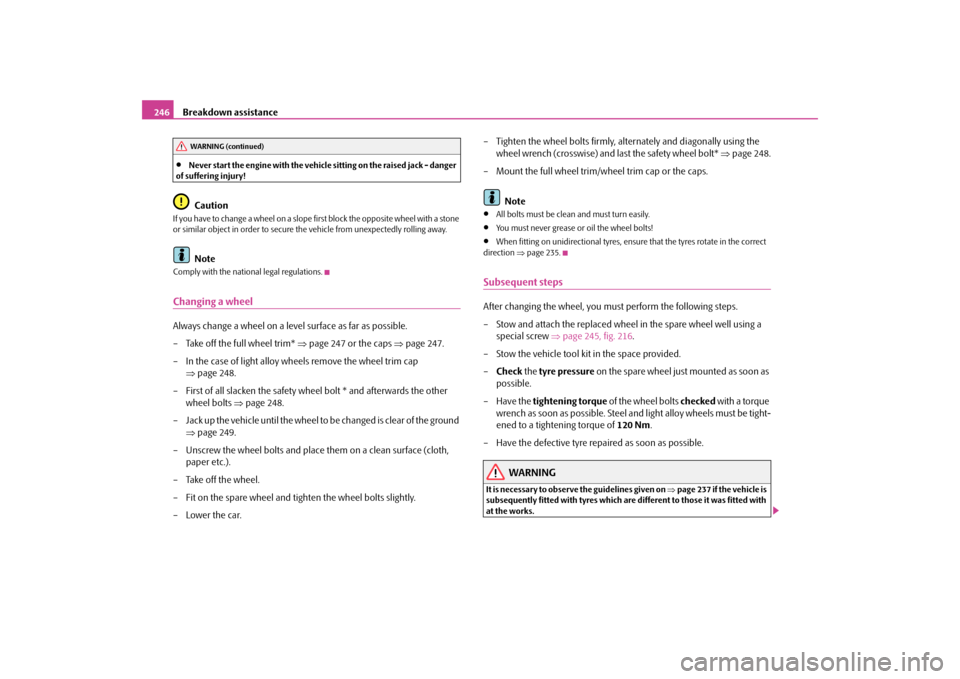
Breakdown assistance
246
•
Never start the engine with the vehicle
sitting on the raised jack - danger
of suffering injury!
Caution
If you have to change a wheel on a slope
first block the opposite wheel with a stone
or similar object in order to secure th
e vehicle from unexpectedly rolling away.
Note
Comply with the national legal regulations.Changing a wheelAlways change a wheel on a level surface as far as possible. – Take off the full wheel trim*
⇒
page 247 or the caps
⇒
page 247.
– In the case of light alloy wheels remove the wheel trim cap
⇒
page 248.
– First of all slacken the safety wh
eel bolt * and afterwards the other
wheel bolts
⇒
page 248.
– Jack up the vehicle until the wheel to
be changed is clear of the ground
⇒
page 249.
– Unscrew the wheel bolts and place them on a clean surface (cloth,
paper etc.).
– Take off the wheel. – Fit on the spare wheel and tighten the wheel bolts slightly. –Lower the car.
– Tighten the wheel bolts firmly, al
ternately and diagonally using the
wheel wrench (crosswise) and last the safety wheel bolt*
⇒
page 248.
– Mount the full wheel trim/w
heel trim cap or the caps.
Note
•
All bolts must be clean
and must turn easily.
•
You must never grease or oil the wheel bolts!
•
When fitting on unidirectional tyres, ensure that the tyres rotate in the correct
direction
⇒page 235.
Subsequent stepsAfter changing the wheel, you must perform the following steps. – Stow and attach the replaced wheel in the spare wheel well using a
special screw
⇒
page 245, fig. 216
.
– Stow the vehicle tool kit in the space provided.–
Check
the
tyre pressure
on the spare wheel just mounted as soon as
possible.
– Have the
tightening torque
of the wheel bolts
checked
with a torque
wrench as soon as possible. Steel and light alloy wheels must be tight-ened to a tightening torque of
120 Nm
.
– Have the defective tyre repaired as soon as possible.
WARNING
It is necessary to observe the guidelines given on
⇒page 237 if the vehicle is
subsequently fitted with tyres which are
different to those it was fitted with
at the works.
WARNING (continued)
s2dk.1.book Page 246 Wednesday, April 8, 2009 12:23 PM